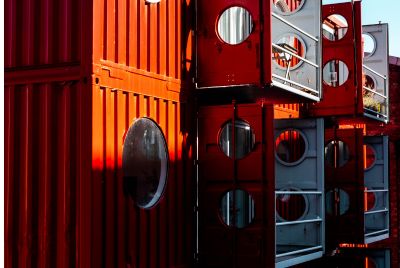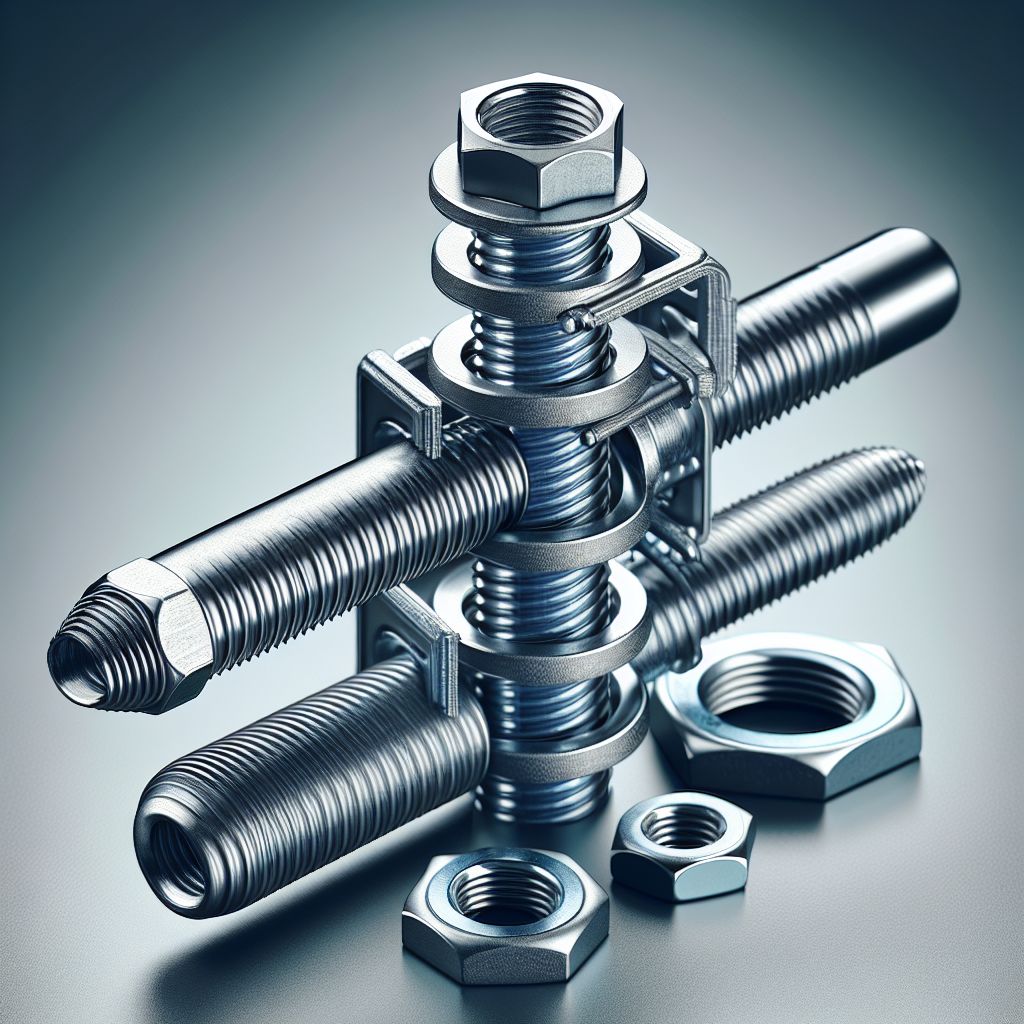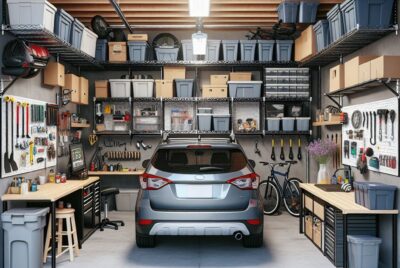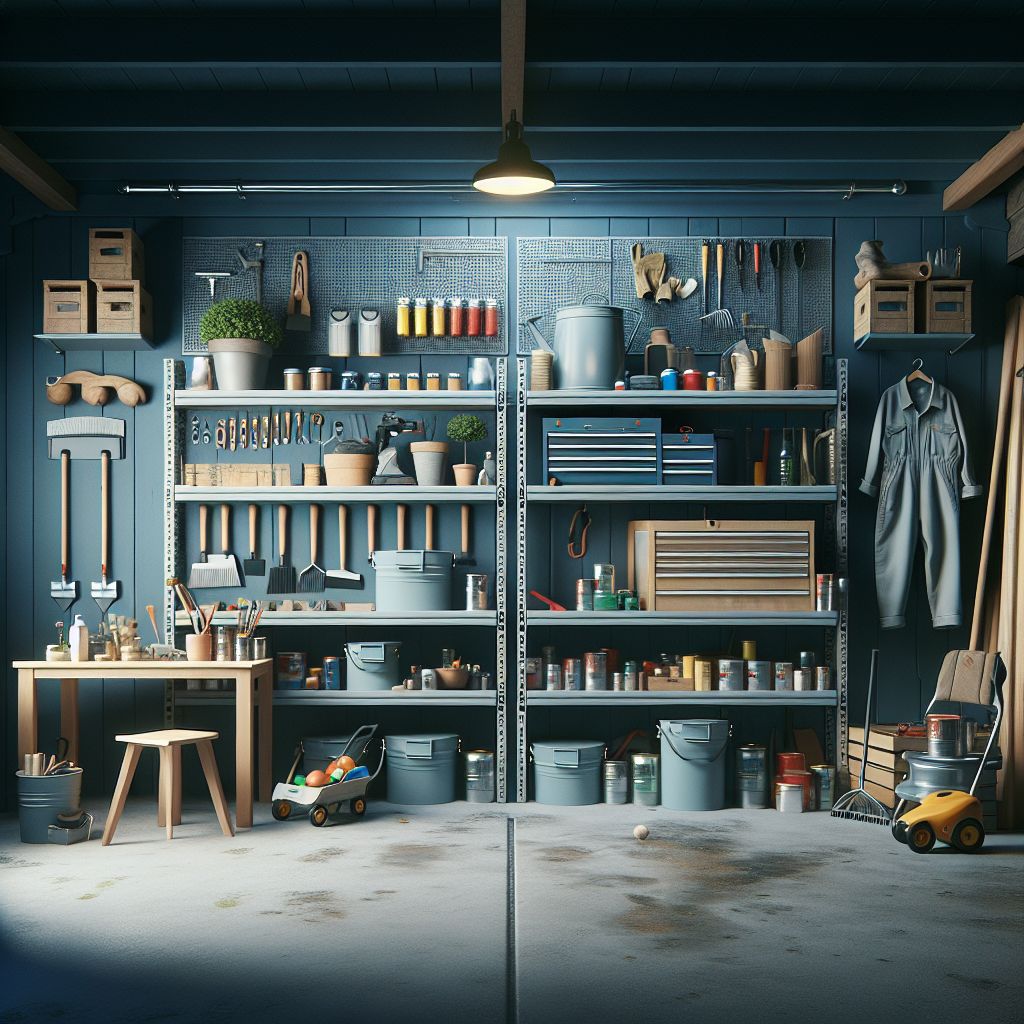Container Garage Design & Conversion Ideas, Storage Solutions
Key Takeaways
- A container garage can be a cost-effective and sustainable option for homeowners looking for additional space.
- With the right design, a container garage can be converted into a multi-functional space, including workshops or studios.
- Choosing the correct container size and making essential modifications are crucial steps in the conversion process.
- Insulation, temperature control, and proper flooring are important for creating a comfortable and usable space.
- Creative customizations, such as green roofs and solar panels, can enhance the functionality and environmental friendliness of your container garage.
Got a shipping container lying around or thinking about a sustainable way to expand your storage space? Container garage conversions are not just a trend, they’re a clever solution to maximizing your property’s potential. Let’s dive into how you can transform a robust steel box into your dream garage, workshop, or even a cozy hangout spot.
Maximizing Your Space with Versatile Solutions
Space is a precious commodity, and a shipping container is like a blank canvas. Imagine a garage that fits snugly in your backyard, holds your car securely, and still leaves room for your tools and toys. That’s the beauty of container conversions—they’re compact yet customizable to fit your needs.
Now, let’s talk about the different ways you can use this newfound space. Besides parking your car, a container garage can be your new DIY workshop, an artist’s studio, or a place for your band to jam without complaints from the neighbors. And the best part? You can often do it without the hassle of traditional construction.
Enhancing Aesthetics and Functionality
Who says a garage has to be a dull, utilitarian space? With a container garage, you’re the architect. Paint it bold colors, add sleek windows, or install a rooftop garden for a touch of greenery. Your garage can be as stylish as it is functional.
Why Container Garages Are Gaining Popularity
More and more homeowners are turning to container garages, and it’s not hard to see why. These sturdy structures offer incredible benefits that traditional materials can’t match.

Cost-Efficiency and Sustainability
First off, reusing a shipping container is a nod to sustainable living. These containers are plentiful and often sit unused after their shipping days are over. By converting one into a garage, you’re giving it a new life and saving on building materials. Plus, they’re usually more affordable than a garage built from scratch.
Speed and Ease of Construction
Time is money, and container conversions can be lightning fast compared to traditional builds. You could have a fully functioning garage in a fraction of the time it takes to lay bricks and mortar. This means less disruption to your daily life and quicker access to your new space.
And let’s not forget about the ease of construction. With some basic tools and a bit of know-how, you can make the conversion a DIY project. But even if you hire professionals, the process is streamlined because the container’s shell is already there, waiting to be customized.
- Identify the perfect spot on your property for the container garage.
- Choose a container size that fits your space and needs.
- Plan for modifications such as doors, windows, and insulation.
- Decide on the interior layout, including storage and work areas.
- Think about exterior customizations to blend with your home’s style.
Designing Your Container Garage
Let’s get into the nuts and bolts of making your container garage a reality. The first step is to envision the layout. Grab some graph paper or a design app and sketch out your ideal space. Consider the flow of movement inside the garage, where you’ll place large items like your car or workbench, and how you’ll store smaller tools and equipment.
Planning Your Layout
It’s all about maximizing the space. Think vertical with shelving and wall-mounted racks. Use fold-down workbenches or tables that can tuck away when not in use. And remember, good design is not just about fitting everything in, it’s about creating a space that’s a joy to use.
Customization Tips for a Unique Spin
Your container garage should reflect your personality and needs. Here are a few tips to make it uniquely yours: For example, you can explore garage cabinet ideas to add stylish and functional storage solutions that match your style.
- Insulation is key—keep your space comfortable year-round.
- Electrical wiring is essential if you want lights and power tools.
- Consider plumbing if you’re planning on washing up in your workshop.
- Windows and skylights can brighten up the space naturally.
- A roll-up or sliding door will make vehicle access a breeze.
And here’s a clever idea: why not add a mezzanine level? If your container is tall enough, a loft space can double as storage or even a cozy office nook.
Ingenious Storage Uses Beyond Just Parking
Think beyond the car. Your container garage is a storage powerhouse. From seasonal decorations to sports equipment, everything can have its place. Organize with labeled bins and racks, and suddenly, you’ll rediscover floor space you never knew you had.
And for those who love to tinker, the container garage can be a sanctuary. Set up a workbench with all your tools within arm’s reach, and you’ve got a DIY haven. Add some soundproofing, and it’s also the perfect spot for band practice or a podcast studio.
Remember, a container garage is not just a place to park. It’s a versatile, customizable space that can evolve with your needs. So let’s roll up our sleeves and turn that steel box into a place you’ll love to spend time in.
Getting Started: The Conversion Process
Turning a shipping container into a garage is an exciting project, but where do you start? First things first, you need to get your hands on a container. You can find these steel boxes in various sizes, but the most common ones are 20 feet and 40 feet in length. Make sure you have enough room on your property and check if you need any permits to place a container there.

“Converting a Shipping Container into an …” from www.youtube.com
Once you have your container, it’s time to think about the conversion process. You’ll need to consider things like insulation, electrical wiring, and plumbing if you’re planning on using the space for more than just storage. And remember, this is a big project, but it’s also a lot of fun. You’re creating a new space that’s entirely yours, so enjoy the process!
- Find a reliable supplier to purchase or rent a shipping container.
- Ensure the container is in good condition, with no major rust or damage.
- Check local zoning laws and obtain necessary permits before installation.
- Prepare the site for your container, making sure it’s level and accessible.
- Plan for the delivery of the container, considering the space needed for the drop-off.
Now that you have your container and a plan in place, it’s time to roll up your sleeves and get to work. The next steps will involve some heavy lifting, both literally and figuratively, as you begin to transform this metal box into your new garage.
Remember, safety first. Always wear protective gear when working on your container, and if you’re not sure about something, don’t hesitate to consult a professional. It’s better to ask for help than to make a mistake that could cost you time and money.
Choosing the Right Container Size
Choosing the right container size is crucial. The standard sizes are 20 feet and 40 feet in length, but they also come in different heights and widths. Consider what you’ll be storing inside the garage. If it’s just a car and some tools, a 20-foot container might be enough. But if you’re looking for more space, perhaps for a workshop or storage solutions, a 40-footer could be the way to go.
Essential Modification Steps
Modifications are where you turn a container from a metal box into a functional space. You’ll need to cut out sections for doors and windows, reinforce the structure if necessary, and seal any openings to prevent leaks. Here’s a quick rundown:
- Mark out and cut openings for doors, windows, and ventilation.
- Frame the openings with steel or wood to maintain structural integrity.
- Install doors and windows that provide security and insulation.
- Apply weatherproof paint and sealants to protect against the elements.
- Consider adding a roof overhang or gutter system for better water management.
With these modifications, your container will start to look less like cargo and more like a cozy, secure space. It’s amazing what a few changes can do to transform the feel of a place.
Security and Weatherproofing Tactics
Now, let’s talk about keeping your container garage secure and dry. Shipping containers are naturally weather-resistant, but they’re not invincible. Inspect your container regularly for any signs of rust or damage and address them promptly.
As for security, consider installing a robust lockbox to protect the padlock from bolt cutters. You might also want to look into security cameras or an alarm system, especially if you’re storing valuable items.
Interior and Exterior Customization
Now comes the fun part—making the space your own. The interior of a container garage can be anything from bare-bones to fully decked out. It all depends on your needs and your budget.
Insulation and Temperature Control
If you plan to spend a lot of time in your container garage, or if you live in an area with extreme temperatures, insulation is a must. It will keep the space cool in summer and warm in winter, making it comfortable year-round. There are various insulation options available, from spray foam to rigid panels, so choose one that suits your climate and your budget.
Flooring Options to Consider
The original plywood flooring of a shipping container might not be ideal for a garage. Consider installing a more durable surface like epoxy or concrete. These materials can withstand heavy use and are easy to clean, making them perfect for a garage environment.
For a more budget-friendly option, interlocking garage floor tiles can be a quick and easy way to upgrade the floor. They come in different colors and styles, so you can customize the look of your garage to match your taste.
Whatever flooring you choose, make sure it’s properly sealed and protected against oil, chemicals, and moisture. This will help to keep your garage looking great for years to come.
Lighting and Electrical Layouts
Good lighting is essential in a garage, especially if you’re using the space as a workshop. LED lights are a great choice because they’re energy-efficient and have a long lifespan. Plan your electrical layout carefully, considering where you’ll need outlets for tools and equipment. It’s best to hire a licensed electrician for this part of the project to ensure everything is up to code.
Don’t forget about natural light. Adding windows or skylights can make the space feel larger and more inviting. Plus, it’ll save you money on your electricity bill during the day.
When planning your lighting and electrical, think about the tasks you’ll be doing in the garage. Task lighting over workbenches and bright, overhead lights for general use will make the space more functional and enjoyable to use.
- Plan for enough outlets to accommodate tools, chargers, and appliances.
- Consider energy-efficient LED lighting for bright, long-lasting illumination.
- Install switches and outlets at convenient locations for easy access.
- Ensure all electrical work is done in accordance with local codes and regulations.
Exterior Aesthetics: Doors and Windows
The exterior of your container garage says a lot about your style. Choose doors and windows that not only look good but also provide the functionality you need. Roll-up doors are great for easy access, while windows can add natural light and ventilation.
And don’t forget about the power of paint. A fresh coat can protect your container from the elements and give it a personal touch. Go with a color that complements your home or get creative with a mural or pattern.
Creative Ideas to Inspire Your Project
Feeling inspired yet? Let’s take a look at some creative ideas that can take your container garage to the next level.
Single-Car Garage Innovations
Even a single-car garage can be a masterpiece of efficiency and design. Install a custom workbench that folds down from the wall, or create a vertical garden on one side to bring in a bit of nature. The possibilities are endless.
Workshop and Hobby Spaces Within Your Garage
Your container garage can be the perfect spot for your hobbies. Whether you’re into woodworking, painting, or car restoration, you can design the space to fit your needs. Add specialized storage for your tools and materials, and you’ll have a dedicated space to enjoy your passion.
The Value of Adding a Green Roof or Solar Panels
Why not make your container garage eco-friendly? A green roof can provide insulation and reduce runoff, while solar panels can generate electricity to power your tools and lights. It’s good for the planet and your wallet.
Merging Multiple Containers for Extra Space
If one container isn’t enough, consider joining two or more together. This can give you the extra space you need for a larger vehicle, a more spacious workshop, or even a separate area for lounging and relaxation.
Remember, your container garage is more than just a place to store your car. It’s a reflection of your creativity and your commitment to sustainability. So have fun with it, and make it a space that you’ll be proud to show off to your friends and family.
Single-Car Garage Innovations
Transforming a 20-foot shipping container into a single-car garage offers a compact, secure, and innovative solution for homeowners with limited space.
When you’re working with a single shipping container, every inch counts. Think about installing custom-built storage cabinets and wall-mounted hooks to keep tools and equipment off the floor. You might also want to consider a foldable workbench – it’s there when you need it and out of the way when you don’t. Smart use of vertical space, such as ceiling-mounted bike racks, can free up the floor for your vehicle and make the garage feel more spacious.
Lighting is another critical factor. Bright, well-placed LED lights can make a big difference in a small space. Consider motion-sensor lights that come on as soon as you enter, so you never have to fumble for a light switch.
For the garage door, a roll-up model is a space-saver compared to traditional swinging doors. They’re easy to operate and can be insulated to keep your garage comfortable in any weather.
Workshop and Hobby Spaces Within Your Garage
A container garage can be the ultimate workshop or hobby space. With the right setup, you can have all your tools and supplies organized and within easy reach. Install sturdy workbenches, pegboards for tools, and shelving units for materials. Good lighting and power outlets are a must, so you can see what you’re doing and use various tools without extension cords running everywhere.
The Value of Adding a Green Roof or Solar Panels
Adding a green roof or solar panels to your container garage isn’t just about being eco-friendly – it’s about adding value and functionality. A green roof can improve insulation, leading to better temperature regulation inside the garage. Solar panels can reduce your energy bills and, in some cases, even allow you to sell excess power back to the grid.
Merging Multiple Containers for Extra Space
When one container isn’t enough, why not combine two or more for additional space? This can be particularly useful if you need room for larger vehicles or want to create separate areas for different activities. With multiple containers, you can design a space that includes a workshop, a storage area, and even a lounge for those well-deserved breaks.
Remember, when merging containers, it’s important to reinforce the structure and ensure that all modifications are weatherproof and secure. It’s a more complex project, but the results can be truly impressive.
Frequently Asked Questions (FAQ)
You’ve got questions, and I’ve got answers. Here are some of the most common queries I come across when it comes to container garage conversions:
What Size Container Is Best for a Single-Car Garage?
For a single-car garage, a 20-foot shipping container is typically sufficient. It’s long enough to fit most cars and still provide some storage space. If you have a larger vehicle or need more room for storage and work areas, a 40-foot container might be a better choice.
Can I Insulate My Container Garage for Year-Round Use?
Absolutely! Insulation is key for making your container garage comfortable throughout the year. Foam board, spray foam, or fiberglass insulation can be used to keep the interior temperature regulated. It’s also a good idea to install a heating and cooling unit if you plan to spend a lot of time in the space.
Don’t forget to insulate the doors and windows as well to prevent drafts. Proper insulation will not only make the space more comfortable but also more energy-efficient.
What Are Some Eco-Friendly Options for Container Garages?
Eco-friendly options for container garages include using recycled or sustainable materials for insulation and interior finishes. Solar panels can provide renewable energy, and a green roof can help with insulation and reduce rainwater runoff. Additionally, using LED lighting and energy-efficient appliances will minimize your environmental footprint.
How Secure Are Container Garages?
Container garages are inherently secure thanks to their steel construction. To enhance security, consider adding a lockbox over the padlock to deter theft. Installing motion-sensor lights and a security system can also help protect your belongings.
Remember to regularly inspect the container for signs of rust or damage that could compromise its integrity, and make any necessary repairs promptly.
What Are the Zoning Considerations for Container Garage Construction?
Before starting your container garage project, check with your local zoning office to understand the regulations and obtain any necessary permits. Zoning laws can vary widely, so it’s important to ensure that your new garage complies with local ordinances regarding size, placement, and use.
Some areas may have restrictions on the type of modifications you can make or require inspections during the construction process. It’s always better to be informed and follow the rules than to face fines or have to make costly changes later on.
*We may earn a commission for purchases made using our links. Please see our Disclosure to learn more.




